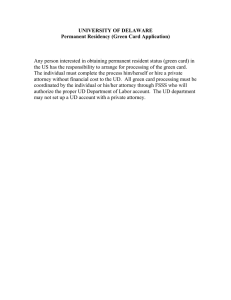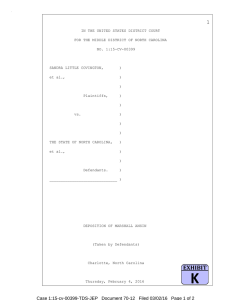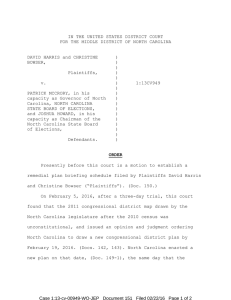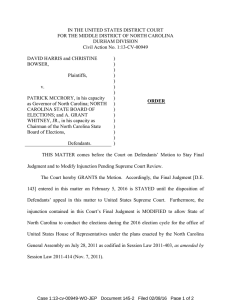THE UNITED STATES DISTRICT COURT FOR THE DISTRICT OF SOUTH CAROLINA
advertisement
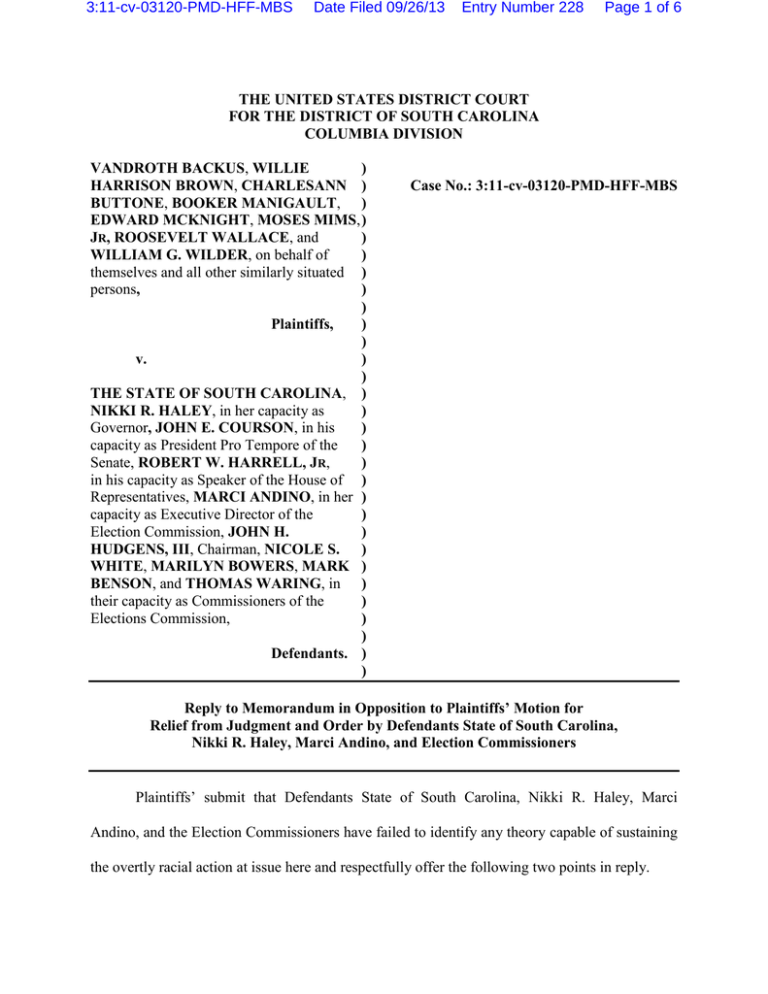
3:11-cv-03120-PMD-HFF-MBS Date Filed 09/26/13 Entry Number 228 Page 1 of 6 THE UNITED STATES DISTRICT COURT FOR THE DISTRICT OF SOUTH CAROLINA COLUMBIA DIVISION VANDROTH BACKUS, WILLIE ) HARRISON BROWN, CHARLESANN ) BUTTONE, BOOKER MANIGAULT, ) EDWARD MCKNIGHT, MOSES MIMS, ) JR, ROOSEVELT WALLACE, and ) WILLIAM G. WILDER, on behalf of ) themselves and all other similarly situated ) persons, ) ) Plaintiffs, ) ) v. ) ) THE STATE OF SOUTH CAROLINA, ) NIKKI R. HALEY, in her capacity as ) Governor, JOHN E. COURSON, in his ) capacity as President Pro Tempore of the ) Senate, ROBERT W. HARRELL, JR, ) in his capacity as Speaker of the House of ) Representatives, MARCI ANDINO, in her ) capacity as Executive Director of the ) Election Commission, JOHN H. ) HUDGENS, III, Chairman, NICOLE S. ) WHITE, MARILYN BOWERS, MARK ) BENSON, and THOMAS WARING, in ) their capacity as Commissioners of the ) Elections Commission, ) ) Defendants. ) ) Case No.: 3:11-cv-03120-PMD-HFF-MBS Reply to Memorandum in Opposition to Plaintiffs’ Motion for Relief from Judgment and Order by Defendants State of South Carolina, Nikki R. Haley, Marci Andino, and Election Commissioners Plaintiffs’ submit that Defendants State of South Carolina, Nikki R. Haley, Marci Andino, and the Election Commissioners have failed to identify any theory capable of sustaining the overtly racial action at issue here and respectfully offer the following two points in reply. 3:11-cv-03120-PMD-HFF-MBS Date Filed 09/26/13 Entry Number 228 Page 2 of 6 First, the Attorney General1 incorrectly contends that this motion asks the Court to reexamine Fifteenth Amendment and Voting Rights Act claims. Defs’ Mem. Opp., 1-2 & 6, ECF No. 227. This is simply incorrect. Plaintiffs’ motion clearly asks that the Court set aside its Order and Judgment solely “to determine whether Act 72 denies equal protection guaranteed by the Fourteenth Amendment.” Pls.’ Mot. Relief J. & O., 2, ECF No. 223. As previously noted, equal protection requires that anytime government decision making even “touches upon” an individual’s race, the use of race must be narrowly tailored to serve a compelling governmental interest. E.g., Fisher v. Univ. of Texas at Austin, __ U.S. __, 133 S. Ct. 2411, 2417 (2013). The Court’s decision in this case assumed that compliance with Section 5 provided the compelling state interest that justified the express use of race and thus satisfied the Fourteenth Amendment. In light of Shelby County, this assumption was incorrect. This merits reconsideration of whether Act 72 can withstand Fourteenth Amendment scrutiny. The Attorney General’s assertion that Plaintiffs’ seek to “re-litigate their case a year and half [sic] after it was tried originally[,]” is not only a misconstruction of the actual relief sought, but also an effort to discourage the Court from granting this motion by suggesting that doing so would require the Court to reopen the record. See Defs’ Mem. Opp., 2. To the contrary, “relitigation” is not only unnecessary, but inappropriate. Since it is undisputed that the State employed racial districting when enacting Act 72, the narrow question the Defendants must address is whether, at the time Act 72 was passed into law, the State sought to accomplish a compelling state interest that could only be accomplished through the use of race. “The justification must be genuine, not hypothesized or invented post hoc in response to litigation.” United States v. Virginia, 518 U.S. 515, 533 (1996) (applying intermediate scrutiny to gender 1 Since these Defendants are all represented here by the South Carolina Attorney General, Plaintiffs shall refer to their position collectively as that of the Attorney General. 2 3:11-cv-03120-PMD-HFF-MBS Date Filed 09/26/13 Entry Number 228 Page 3 of 6 discrimination claim); see also Hays v. Louisiana, 936 F. Supp. 360, 369 (W.D. La. 1996) (rejecting proffered race-neutral explanations of districting scheme as “patently post-hoc rationalizations” unsupported by the record). Accordingly, upon granting this motion, the Court’s task is to review the existing record to determine whether any compelling state interest other than Section 5 compliance was present when the Legislature enacted Act 72. In the absence of such a justification, the Court’s analysis need go no further and the law fails strict scrutiny review. However, if the Defendants can point to a cognizable compelling interest, then they must likewise show that racial districting was necessary to accomplish that goal at the time it was undertaken. Here too, post hoc justifications do not suffice. With this legal framework in mind, the Attorney General’s suggestion that Plaintiffs seek to re-litigate this case is an empty threat. This motion merely asks that the Court reexamine the record post Shelby County to determine whether any justification capable of sustaining Act 72 existed at the time of enactment. Second, instead of identifying a defensible compelling state interest, the Attorney General makes the astonishing assertions that “since there has been no change in the law, there is no valid legal reason” to grant this motion. Defs’ Mem., 2. The Attorney General’s argument appears to turn on the assumption that since the Voting Rights Act’s bail-in provision (i.e., Section 3) is still (presumably) a viable mechanism to subject discriminatory jurisdictions to Section 5’s remedial scheme, that South Carolina legally relied on Section 5’s racial districting mandate in 2010 and can thus still rely on Section 5 to defending its otherwise racially tainted law. See Defs’ Mem., 3-5. This conclusion is both confused and incorrect. 3 3:11-cv-03120-PMD-HFF-MBS Date Filed 09/26/13 Entry Number 228 Page 4 of 6 South Carolina did not become a covered Section 5 jurisdiction through Section 3’s bailin procedure.2 South Carolina was swept in as a covered jurisdiction pursuant to Section 4’s coverage formula—the very section struck down in Shelby County. See South Carolina v. Katzenbach, 383 U.S. 301, 317-18 (1966) (explaining that Section 4 brought South Carolina and other jurisdictions under the federal preclearance regime). So while the Court declined to strike down Section 5 as a remedy that Congress might be able to justify under a future coverage formula, “[s]uch a formula is an initial prerequisite to a determination that exceptional conditions still exist justifying [Section 5’s] extraordinary departure from the traditional course of relations between the States and the Federal Government.” Shelby Cnty., Ala. v. Holder, __ U.S. __, 133 S. Ct. 2612, 2631 (2013). In other words, states are not subject to Section 5 in the absence of a congressionally-enacted and constitutionally-applied coverage formula bringing them back into the preclearance regime. Of course the Attorney General’s position is particularly precarious since he has publically touted the Shelby County decision, concluding that “[o]ver time, great strides have been made and Sections 4 and 5 have become obsolete.” Press Release, S.C. Atty. Gen. (date unknown) (attached as Exhibit A and available at: http://www.scag.gov/archives/9396). On this point, the Supreme Court, the Attorney General, and Plaintiffs all agree. However, while the Attorney General demagogues the demise of Sections 4 and 5 in South Carolina as ending “an extraordinary intrusion into state sovereignty” that required the State to “ask for permission” and “jump through the extraordinary hoops demanded by federal bureaucracy,” id., he also urges this Court to conclude that 2 Whether the State could be subjected to preclearance pursuant to Section 3’s bail-in procedure would require a complex judicial determination as to whether the State has habitually violated the 14th and 15th Amendments such that federal oversight was warranted. No such action is pending in any court and that is not the issue here. 4 3:11-cv-03120-PMD-HFF-MBS Date Filed 09/26/13 Entry Number 228 Page 5 of 6 The lack of preclearance requirements do not qualify as a sufficient change in the law or facts that would warrant re-opening this case because as noted above, Shelby County did not change any law regarding vote dilution or racial gerrymandering claims as those claims are properly under § 2 and § 3 of the Voting Rights Act. Defs’ Mem., 6. The Attorney General cannot have it both ways. Section 5 cannot at the same time be an onerous and unconstitutional federal intrusion and a compelling and constitutional justification of the State’s racial decision making. Shelby County resolves these issues and renders the Attorney General’s response unresponsive and thus unhelpful to resolving the question presented here. The Attorney General fails to support his conclusion with any Rule 60(b) or equal protection analysis. Moreover, his conclusion is completely untethered from Supreme Court precedent consistently voicing ambivalence toward remedial racial districting even when the alleged compelling interest is Section 5 compliance. See e.g., Georgia v. Ashcroft, 539 U.S. 461, 491 (2003) (Kennedy, J., concurring) (observing that “considerations of race that would doom a redistricting plan under the Fourteenth Amendment or § 2 seem to be what save it under § 5.”); Shaw v. Hunt, 517 U.S. 899, 908, 911 (1996) (assuming Voting Rights Act compliance was a compelling state interest, the challenged districting scheme was not narrowly tailored). Shelby County ends this judicial paradox by striking down Congress’s 2006 Reauthorization of Section 5 to the covered jurisdictions. See Defs’ Mem., 4 (conceding that “Shelby County simply found that there was no longer a wrong to be remedied, at least a wrong identified under § 4 of the Voting Rights Act.”). In the absence of this justification, the Attorney General offers no explanation as to why the unconstitutionally-applied Section 5 should be credited as a defense of Act 72 of 2011. Nor does he offer an alternative justification for the 5 3:11-cv-03120-PMD-HFF-MBS Date Filed 09/26/13 Entry Number 228 Page 6 of 6 challenged racial decision making. Respectfully, neither exists and this motion should be granted. Respectfully submitted by, s/ Richard A. Harpootlian Richard A. Harpootlian (Fed. I.D. #1730) rah@harpootlianlaw.com Graham L. Newman (Fed. I.D. #9746) gln@harpootlianlaw.com M. David Scott (Fed. I.D. #8000) mds@harpootlianlaw.com Christopher P. Kenney (Fed. I.D. #11314) cpk@harpootlianlaw.com RICHARD A. HARPOOTLIAN, P.A. 1410 Laurel Street Post Office Box 1040 Columbia, South Carolina 29202 (803) 252-4848 (803) 252-4810 (facsimile) Columbia, South Carolina September 26, 2013 6

